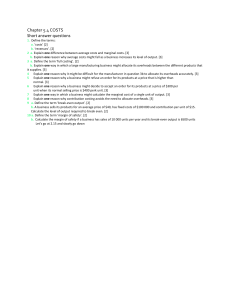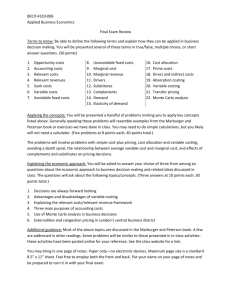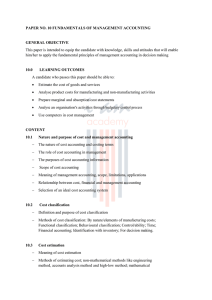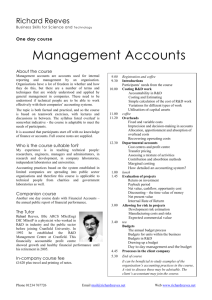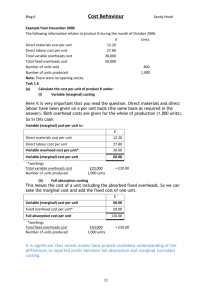Cost & Management Accounting 2 Page 1 of 3 SYLLABUS COST
advertisement
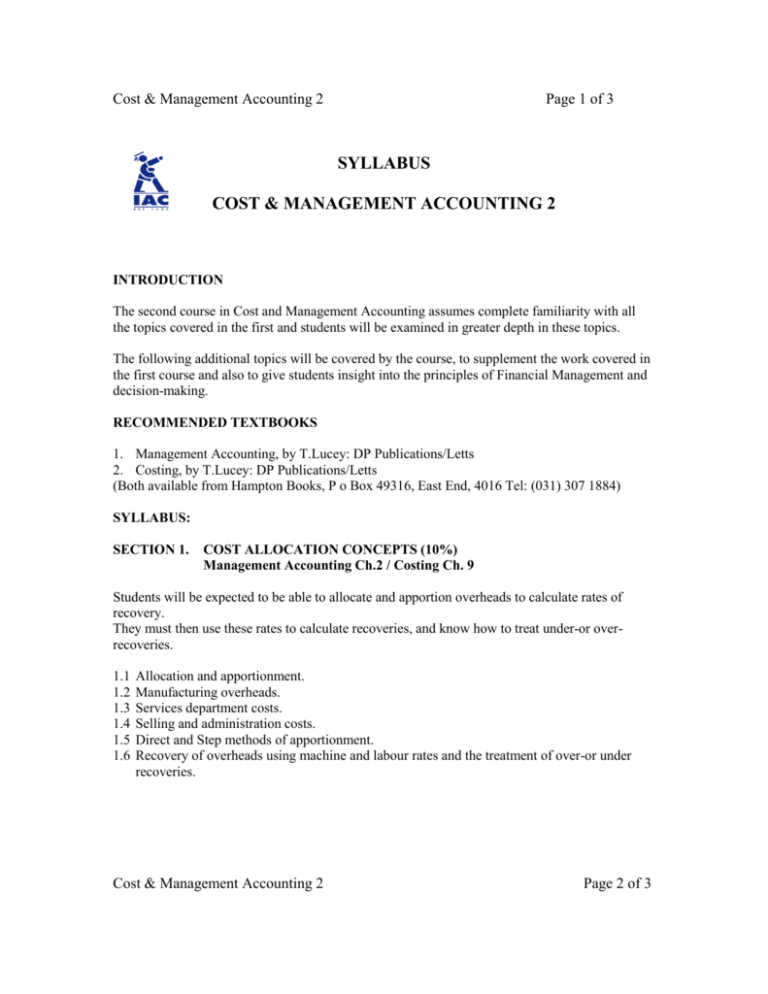
Cost & Management Accounting 2 Page 1 of 3 SYLLABUS COST & MANAGEMENT ACCOUNTING 2 INTRODUCTION The second course in Cost and Management Accounting assumes complete familiarity with all the topics covered in the first and students will be examined in greater depth in these topics. The following additional topics will be covered by the course, to supplement the work covered in the first course and also to give students insight into the principles of Financial Management and decision-making. RECOMMENDED TEXTBOOKS 1. Management Accounting, by T.Lucey: DP Publications/Letts 2. Costing, by T.Lucey: DP Publications/Letts (Both available from Hampton Books, P o Box 49316, East End, 4016 Tel: (031) 307 1884) SYLLABUS: SECTION 1. COST ALLOCATION CONCEPTS (10%) Management Accounting Ch.2 / Costing Ch. 9 Students will be expected to be able to allocate and apportion overheads to calculate rates of recovery. They must then use these rates to calculate recoveries, and know how to treat under-or overrecoveries. 1.1 1.2 1.3 1.4 1.5 1.6 Allocation and apportionment. Manufacturing overheads. Services department costs. Selling and administration costs. Direct and Step methods of apportionment. Recovery of overheads using machine and labour rates and the treatment of over-or under recoveries. Cost & Management Accounting 2 Page 2 of 3 SECTION 2. PROFIT PLANNING (25%) Management Accounting ch. 7, 336 / Costing ch. 22/23 The following topics need to be studied in details and students will be expected to be able to prepare budgets resulting in the budgeted income statement and balance sheet, be able to flex a budget and evaluate the necessary capital budgets. 2.1 2.2 2.3 2.4 2.5 Basic principles of budgeting The budget period and the budget committee. The master budget, and ancillary budgets Flexible budgets Capital budgeting (including the concept of Present Value, calculating Net Value, Effects of taxation and Ranking of investments). SECTION 3. PRODUCT PRICING (10%) Managing Accounting ch.3, 15 / Costing ch. 18 p332 Students should be able to identify revenue and cost curves and demonstrate ability to highlight marginal revenues and costs. They should be able to compute prices using cost plus or other strategies. 3.1 Total revenue, and total cost curves. 3.2 Marginal revenue, and marginal cost curves 3.3 Cost-plus pricing 3.4 Determining mark-up percentages 3.5 Pricing new products SECTION 4. COMPANY FINANCIAL ANALYSIS (25%) Management Accounting p238 The following topics need to be studied in detail, allowing analysis and evaluation ratios calculated. Students must be able to produce a cash flow from information available. 4.1 Cash flow Statements. 4.2 Financial Ratio Calculation including profitability, liquidity, asset usage and capital ratios. SECTION 5. MANAGING CAPITAL (10%) Management Accounting p238 Students must identify the components of working capital and determine strength and weakness in policy which they could use to prepare a new policy. 5.1 5.2 5.3 5.4 5.5 Importance of working capital management. Working capital policy. Impact of inflation, sales growth and sale demand on working capital. Managing current assets. Managing current liabilities. Cost & Management Accounting 2 Page 3 of 3 SECTION 6. THE COST OF CAPITAL (10%) Management Accounting p300 Students should list the types of capital and costs of dept, demonstrating the liability to calculate marginal cost of capital and discuss the effects of financial leverage. 6.1 Types of share capital. 6.2 The cost of debt. 6.3 Marginal cost of capital. 6.4 Financial leverage. SECTION 7. LONG TERM FINANCING (10%) These topics should be studied broadly to allow students to explain the different of finance available and to choose optimum components. 7.1 7.2 7.3 7.4 Ordinary and Preference Shares. Long-term loans and debentures. Leasing Sale and leaseback EXAMINATION Structure: Between 4 and 7 questions, all of which must be answered. Mark allocation roughly according to Weighting. Not open book. Type of questions: Approximately 20% theory/knowledge and 80% application of that knowledge in a business situation. You are given information on a business, and you are asked to provide answers to questions concerning that business eg. What price should they sell at to make 30% on marginal cost? Non-standard equipment required: Non-programmable calculator. ---oooOOOoo—
